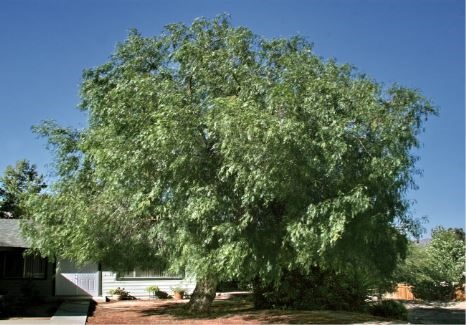
Plant Form: Tree
Water Use: Very Low
Mature Size: 25-40 ft. tall & wide
Exposure: Full sun
Bloom Time: Summer (June-August)
Hardiness: Cold Hardy to 15°F
Native to: Peru, South America
California Pepper Tree is an evergreen tree with a weeping form that creates expansive shade when given room to spread. This fast-growing tree needs only occasional watering when established, and develops a fantastically gnarled trunk with interesting peeling bark. Its bright green leaves are divided into many narrow leaflets. Pendulous creamy white flowers in summer develop into small red berries on female trees from fall into winter. California Pepper Tree was named due to its wide use in California since early missionaries planted it at their missions, but this plant is actually native to the Peruvian Andes. This tree produces heavy litter from foliage and falling fruit, deterring understory growth, and its invasive roots can crack and heave nearby pavement, foundations, and pipes. Properly used, this tree is outstanding. Avoid planting between sidewalks and curbs, near house foundations, patio cement, sewers or septic tanks, or in lawns. Plant along roads or driveways without curbs, in play areas, lounging areas, or to frame a large gateway. It can also be used as a hedge when planted two feet apart and sheared into a billowy hedge.
THIS MONTH IN YOUR DESERT-SMART LANDSCAPE
Frost is likely on dry, windless, clear nights this month.
- Keep plants watered to help prevent frost damaged
- Wrap irrigation valves and pipes to protect from freezing
- Turn off irrigation timers if it rains
- Apply mulch around plants to retain water and soil, and to feed nutrients into soil with each rain
- Prune roses and summer-blooming deciduous fruit trees
- Don’t prune front-damaged plants until spring growth appears
- Plant bare-root trees and shrubs now through early March
- Mulch around plants and under downspouts with bark, compost, or gravel